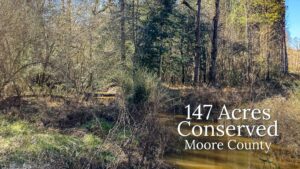
by Ruth Ann Grissom
Why are so many of us in the South infatuated with English ivy? Perhaps we use it to create a veneer of Old World charm or associate ourselves with the prestige of the Ivy League. Perhaps we resort to using it only after other groundcovers have failed. English ivy (Hedera helix) thrives on many challenging sites, especially shady slopes inhospitable to turf. It also eliminates the need to irrigate, fertilize and mow. What’s not to like?
Well, even in a region known for hospitality, ivy can quickly wear out its welcome, becoming the pleasant acquaintance who arrives for a brief visit then refuses to leave. He soon monopolizes your guestroom and strews his belongings throughout your house. You can’t turn your back for a minute or else he might pilfer a family heirloom. When his mess spills over into your yard, even your neighbors start to complain about his boorish behavior. This is the dark side of ivy’s behavior – he’s a well-bred cad.
Ivy is now considered invasive throughout the Southeast, as well as the states that are home to the venerated campuses of Princeton, Penn and Brown. On the ground, ivy creates dense mats, choking out our native vegetation. It also harbors a pathogen harmful to maples, oaks and elms. A social climber at heart, ivy isn’t content being trod upon. No, it seeks every opportunity to elevate itself, clambering up any vertical surface.
Behind the stately façade of ivy-covered buildings, the wood is rotting and the mortar is being dislodged. Trees are also at risk. As ivy works its way toward the crown, it clings to the trunk with thick, hairy roots, and smothers the branches with foliage. As limbs die off, the tree comes to resemble a stalk of broccoli. With only a tuft of leaves at the top, the tree can’t produce enough energy to sustain itself. But ruthless ivy doesn’t care. Unlike a parasitic plant, it doesn’t draw nutrients from its host; it merely needs a support. Eventually, long tendrils fall to the ground, where they sprout and begin to grow upward again. The tree becomes so heavy, it’s vulnerable to toppling over during heavy wind or precipitation.
At this point, ivy fashions a new identity for itself, transforming into an aerial shrub. Its short branches sport clusters of greenish-yellow flowers which then produce drupes of midnight blue. By early spring, many desperately hungry birds feast upon these fruits. Mildly toxic, they induce gastrointestinal upset, which actually aids in seed dispersal. Insidious ivy can pop up far from its source.
If you must have ivy, please stay on top of it. Even though you don’t have to mow it every week like fescue, don’t consider it maintenance-free. Keep it trimmed, especially during the growing season. If it has run rampant over your landscape, the first plan of attack is to cut the thick vines at the base of trees and shrubs. The runners will eventually die back and start to slough off on their own. Pulling them from the limbs can be dangerous, and it can damage your ornamentals.
Wait until winter to address any ivy remaining on the ground. When the soil is wet, it’s relatively easy to pull. Runners can often be traced to a central point which might require some digging. Another option is to cut the stems and paint them with an herbicide like triclopyr or glyphosate. If you decide to spray, use a formula with a surfactant to help the herbicide stick to the glossy leaves. Spraying in early spring is most effective, but a late-winter spray minimizes the risk to other vegetation. The latter will be most effective during one of those weeks in February when we’re graced with temperatures in the 50s. Ivy can be tenacious, so be sure to use an adequate concentration.
I rarely encounter ivy in remote natural areas of the Uwharries – periwinkle (Vinca minor) was apparently the groundcover of choice at old farmsteads – but it often invades forests adjacent to neighborhoods in town. Even there, it warrants removal. My sister spent years pulling ivy from the wooded slope behind her house. Every winter, she and a couple dedicated friends made a little more headway, spurred on by the native wildflowers that blossomed in their wake. The ivy had smothered a lush carpet of bloodroot, trillium and black cohosh.
Why chase after English ivy when there are so many brilliant alternatives for challenging sites? Try natives such as heuchera, wild ginger, white wood aster and Carolina jessamine. Many ferns will tolerate dry shade, as will epimedium and strawberry begonia. I’ve found the graceful Japanese anemone to be surprisingly rugged. Lamb’s ears and creeping sedums thrive in full sun. Not so long ago, I would have included Lenten rose on this list, but I’m growing concerned it could escape from cultivation and become problematic for our natural areas as well.
The Randolph Cooperative Extension Service has a succinct article on combating English ivy and other troublesome vines (http://randolph.ces.ncsu.edu/weeds-english-ivy/), and more information can be found at NC State University’s Going Native website (http://www.ncsu.edu/goingnative/howto/mapping/invexse/englishi.html). To continue your ivy league education, check out the Washington Post article on the differences between English and Irish ivy (http://www.washingtonpost.com/wp-srv/special/metro/urban-jungle/pages/130219.html).